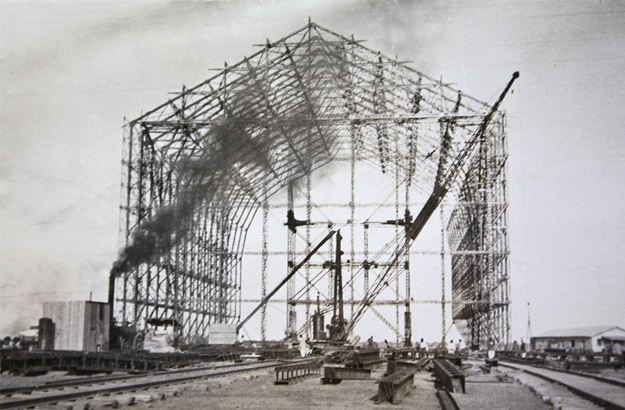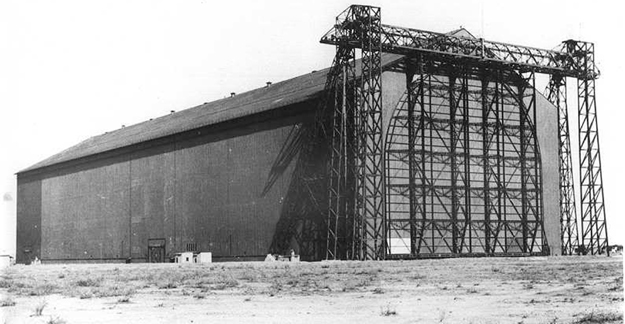Author : Irfan Moeen Khan
 |
| In the age of airships, Karachi was a crucial link in a chain that was meant to keep the British Empire united. PHOTO: AIRSHIP HERITAGE TRUST COLLECTION |
A relic of a bygone era, the airship or the dirigible was a
machine that, once upon a time, personified the adventurous European
spirit. One can clearly picture these huge crafts, piloted by men
wearing scarves and goggles who would go face the wild blue yonder with a
giant bag of (generally explosive) gas and some propellers.
In its German version, the dirigible known as the Zeppelin was used as a means of passenger travel for over 30 years.
But its career ended in a few fiery minutes when the German passenger airship LZ 129 Hindenburg caught fire on May 6, 1937. And so with the Hindenburg disaster, the age of the dirigible ended came to an abrupt and explosive end.

But in 1924, thirteen years before that horrific crash, the British Empire looked at these giant airships and saw a way to link its far-flung empire. The Airship Guarantee Company, a subsidiary of the famed British Engineering Company Vickers, was given the contract to design and build a non military airship (the R-100) that could transport 200 persons. The other airship, the R-101, was built by the Royal Airship Works under the British Air Ministry and became operational in October 1929. To date, it is the largest man-made flying object ever built. It had a total length of 777 ft as compared to the 238.6 ft length of Airbus A380, the largest passenger airliner at present. It truly was a Titanic of the air. But just like its ill-fated counterpart, it met a tragic end.
The “Imperial Airship Scheme 1924-1930” was meant to connect the far ends of the world — Montreal in Canada with Wellington in New Zealand. Interestingly enough, Karachi, the western-most port city of British India, was selected as a major docking station. Between the First and the Second World Wars, the RAF’s Drigh Airfield (now PAF Base Faisal) was an important support facility. Perhaps the brides and the bridegrooms who tied the knot in Gulshan-e-Iqbal’s famous Karachi Aero Club could testify that this venue was once known as the Country Club and, even to this day, has its very own airstrip.
This airstrip began from the present location near the Institute of Cost and Management Accountants’ Gulshan campus and extended up to the Gillani Railway station near Hassan Square. Back then, University Road was known as Country Club Road, which is why the two bowling ends in the National Cricket Stadium were called the Pavilion end and the “Country Club Road End” instead of the “University Road End” that we have today.

The Country Club produced some of the best pilots in the history of Pakistani aviation, with a fairly good resource pool of trained manpower to handle the R-101’s docking and ground operations. Karachi’s geographical location and its gentle climate also played a major role in its selection as a major base in the overall “Imperial Airship Scheme”.
Then in 1927, the British Government started the construction of an airship mast, a hydrogen plant and a huge hangar in Karachi, just a few hundred meters from where PIA’s Ispahani Hangar stands today. The local population was quick to name it the “Kala Chapra,” which meant simply “The Black Shed”. Even today, the road which connects Shahrah-e-Faisal and Gulistan-e-Johar is called the Kala Chapra road by some old timers, and the local bus stop still goes by the same name.

This hangar was larger than the two sheds at the home base of the R-100 and R-101 in Cardington, UK. The British press of the time reported it as the largest manmade structure in the whole of the British Empire. During its design and construction, the expected future traffic of airship was kept in mind, and therefore the size of the hangar was 850ft long, 170ft high, and 180ft wide — a size that could easily house the newer R-102 which was designed to be 822ft long. In addition to this humongous hangar, a docking mast was also built to dock the ship.
For verification, I contacted the Airship Heritage Trust and was told that one extra engine and some basic tools were dispatched to Karachi well before R-101’s scheduled arrival in Karachi.
Wing commander (retd) Aijazuddin Khan of the Pakistan Air force, who has extensively flown in this region, recalls the black shed vividly “We used Kala Chapra as a land mark when approaching Karachi because of its massive size. It was clearly visible from a distance.”
At 6:42 pm on Saturday, 4th of October 1930, R-101 lifted
off from its Cardington hangar for its journey to Karachi, which at that
was time under the Bombay Presidency Government of British India.
Unfortunately the airship met with an accident en route to Karachi and
was destroyed completely. Out of a total of 54 passengers, 48 died in
that crash. The accident dealt a death blow to the British Government’s
“Imperial Airship Scheme,” and other options for connecting the far
corners of the Empire had to be thought of. Ironically, the Zeppelin
Airline Company of Germany bought some of the scrap, but whether they
used it for manufacturing the Hindenburg, remains a mystery. In any
case, while the R-101 ended British Airship ambitions, the Hindenburg
dealt the final blow to the industry internationally.

On 1st August 1952, Pakistan Aviation Ltd issued a tender to bring down the massive Kala Chapra and material from it was later used by Pakistan Railways. Thus the structure was sentenced to the dustbin of history, and exists now only in the memories of those who, in their childhood, played around it or sneaked into it secretly when they were kids. Today if you go to this area and ask about Kala Chapra, most will say that it was just a myth. Others would claim that it was a stable of horses during British Rule while some will state that it was a hangar made to house the Royal Indian Aircrafts during World War II. Only, a handful of people know the true history of the Kala Chapra, and now you’re one of them!






No comments:
Post a Comment